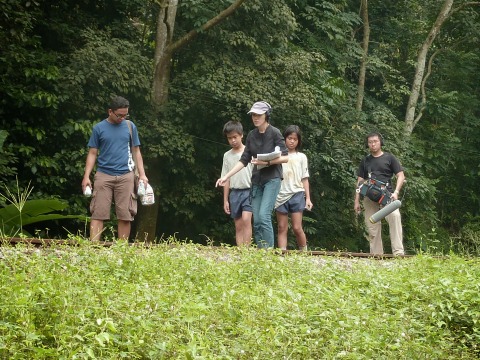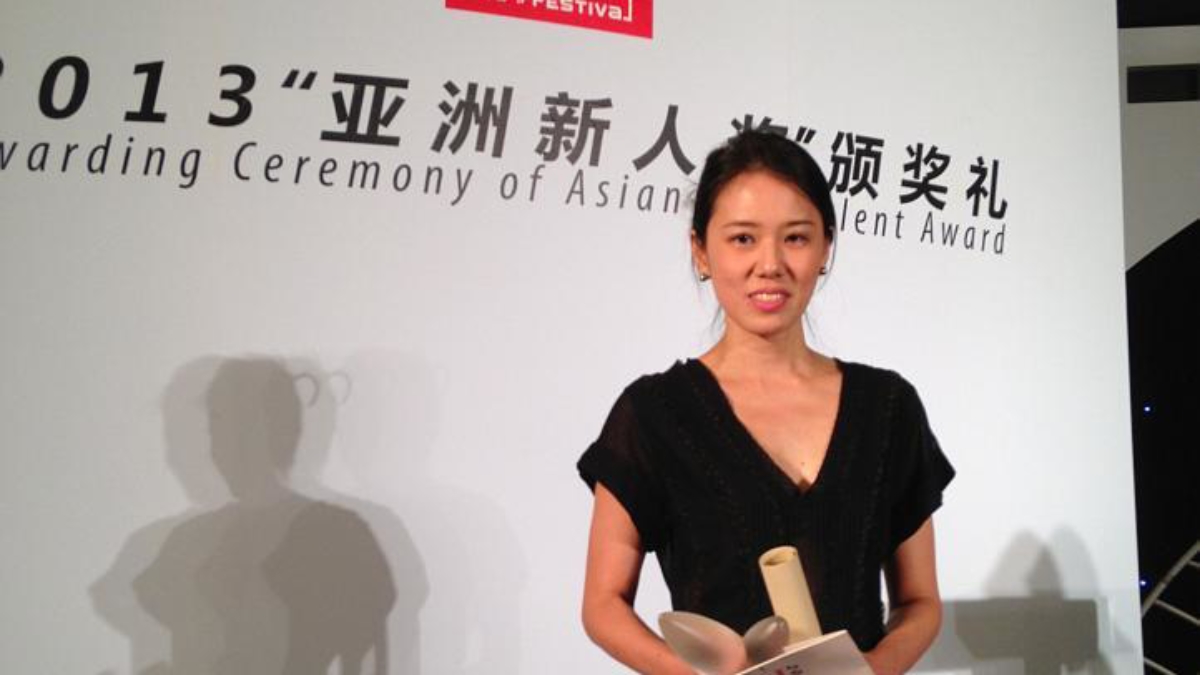CineVue reunited with Director Wong Chen-Hsi this March and interviewed her on the process of filmmaking for Innocents, a 2012 Singaporean film and AAIFF’13 Feature Film about the friendship between two tweens, each estranged at home.

Production Still of Wong Chen-Hsi and Crew
CineVue: How did you come up with the story? Is there any autobiographical element in it?
Wong Chen-Hsi: No, other than autobiographical. It originally developed from the memory of my childhood in the 80s. What I remember is that there was a boy that got beaten a lot. The situation was a lot worse than that in the film. And that really stuck in my head.
CV: So is this kind of totalitarian control over the children in school and family common back in the 80s?
WC: It is quite interesting that some of the younger audiences in their teens or early twenties don’t even believe that such thing can actually happen in school or family. On the contrary, the older audiences would said, “That is exactly how my teacher was.” And I share the same memory, so that was definitely quite common back in the 80s.
CV: You put a lot of effort in the art/set design of the film. How was the process?
WC: The idea of the film is of course about innocence, but the film also reflects the girl’s journey. The color goes from warm to cool. We spent a lot of time doing color correction in post-production. Also when doing the set design, we paid a lot of effort to find the right props for the film, for example the uniform. At the beginning, the uniform was clean and very fitting, but in the end, it got darker, baggy and more brownish. It aged throughout the course of the narrative.
CV: What is the importance of doing a film about this particular time?
WC: It wasn’t a deliberate analogy, but when I was writing the script and making the film, I realized that there is a parallel between children growing up in their everyday life and being citizens in Singapore. Singapore has this very male dominant, paternal authority in the society. As children in a family and ordinary citizens in the society, you can’t really do anything against the authority. So for me, the parallel is very normal and clear. That is the subtlety I intended to bring up in the film.
CV: The characterization of the boy Ah Huat is a stark contrast with that of Syafiqah. Singapore has a large group of Chinese diaspora. Ah Huat is one of that ethnic group, while Syafiqah is Malay. It is interesting and comparatively rare to see such representation of diverse ethnicity in Singaporean films. How did you come up with these two specific settings of the characters?
WC: I’m very glad that you mention this. It’s indeed very common to see only Chinese people in most of Singaporean films. Originally, I had casted a Chinese girl for Syafiqah, but she wasn’t available a month ago before we started shooting. So I was very desperate. Then, it occurred to me that it would a great if Syafiqah is Malay, because I can switch the language of the film back to English as I’d wanted at the very beginning.
CV: How was this portrait received when the film was released in Singapore? Did the audience feel that it was a truthful depiction of the era and demography of the country?
WC: I think it really depends on what age group you are talking to. Again, if you are in your 50s, 60s or 70s, you might find the film really represent what you have been through when you were a child or teenager. If you have audience of a younger generation, you might question that why the character all speak proper English, instead of Singlish. In terms of racial multiplicity, many non-Chinese audiences came to me and said, “Finally, there is a film that wasn’t all about Chinese.” Again, it’s sad that there aren’t many of these films, but it also shows that how Innocents is different from other Singaporean films.
CV: The presence of violence in the film is quite explicit. We see teacher beating up students. And also, Syafiqah feels a lot of pressure from her family. There is a scene when the two protagonists find a corpse in the drain. Is that the social environment around that time that you feel this surveillance everywhere and have no idea what can happen to an individual? That particular scene seems to speak of a larger film topic.
WC: From one perspective, it is a common motif in literature and film, works like Heart of Darkness that something beautiful can shatter so suddenly. For me, the film is a children’s Heart of Darkness. People can literally get drowned by the harshness of society and environment.
CV: I guess a lot of audiences are curious about what happened to An Haut in the end of the film?
WC: A lot of them so ask me about that. The answer diverts among the audience. I guess it depends on whether you are an optimist or pessimist.
CV: The sound effect of the film is very delicate. Did you have what you wanted to achieve from the beginning?
WC: I knew I didn’t want to have the soundtrack playing throughout the film. I tend to use only diegetic sound in my works. But in this film, we decided to emphasize the moments of the children characters, to make it more private and special through the juxtaposition of music. With the music, I still hold on to the idea of found sound, so we would record the sound on set and add some notes to it afterwards. My sound designer is very specific on highlighting the key points of the film. We have a major verse for specific moments and only add some alternatives to it for certain purposes.
CV: The film is set before the digital era, so people have fewer communication means, which ties in with the isolation that can be inversed into nature. Would you talk more about the communication between individuals and assimilation among a larger community?
WC: The kids are very isolated, but again the sound becomes a crucial connective device. It helps to connect the characters with the environment. For example, you hear the sound of tree or the sound of air, and then you may associate it with the inner state of the character. It is impossible to for instance, create the “sound of soul”, but we are able to represent that through a more metaphorical way. The sound can be translated into images through such effective ways.
CV: When did you decide to become a filmmaker?
WC: I’ve been always interested in film. But I didn’t think of learning about in when I was in university, instead, I majored in philosophy. Then, after I graduated, I worked in Boston for a while and went to USC for the MFA in film production program. It was during that time that I realized that I’m really fascinated by film and wanted to become a filmmaker.
CV: Were you a fan of Singaporean film before you came to the states?
WC: I didn’t know much about Singaporean film back at that time. I was more into European films, American films, films by Client Eastwood, western spaghettis for instance. My farther watched a lot of Kurosawa’s films when I was little, so I grew up watching more of macho types of films.
CV: I haven’t watched many Singaporean films, either. But I found in my research that filmmakers like Eric Wu were one of the key figures in the 90s and early 2000s. Do filmmakers of the previous generation like him help the younger generation?
WC: Yeah, Eric is always very supportive. He gives us a lot of advices and introduces us to people in the industry. He is very generous and kind to all of us.
CV: It is said that most of the Singaporean audiences are more interested in comedies. Is it changing now? Or is there always a tradition of alternative or art-house cinema in Singapore?
WC: I guess it depends on who the audience is. I’m really surprised at the reception and box office of the film. I though, to be honest that I can’t come up with a reason that anybody would come to the film. I was really stressed out. But it turned out that the audience was fascinated by the film. I guess sometime not everybody wants only slapsticks and also audience of my generation can really relate themselves to the film.
Main image: Production still from Innocents. Photo credit: Image courtesy of SINdie.

